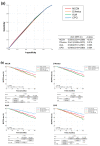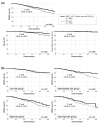Optimizing External Beam Radiotherapy as per the Risk Group of Localized Prostate Cancer: A Nationwide Multi-Institutional Study (KROG 18-15)
- PMID: 34073100
- PMCID: PMC8198120
- DOI: 10.3390/cancers13112732
Optimizing External Beam Radiotherapy as per the Risk Group of Localized Prostate Cancer: A Nationwide Multi-Institutional Study (KROG 18-15)
Abstract
Purpose: This nationwide multi-institutional study analyzed the patterns of care and outcomes of external beam radiotherapy (EBRT) in localized prostate cancer patients. We compared various risk classification tools and assessed the need for refinements in current radiotherapy (RT) schemes.
Methods and materials: We included non-metastatic prostate cancer patients treated with primary EBRT from 2001 to 2015 in this study. Data of 1573 patients from 17 institutions were analyzed and re-grouped using a risk stratification tool with the highest predictive power for biochemical failure-free survival (BCFFS). We evaluated BCFFS, overall survival (OS), and toxicity rates.
Results: With a median follow-up of 75 months, 5- and 10-year BCFFS rates were 82% and 60%, and 5- and 10-year OS rates were 95% and 83%, respectively. NCCN risk classification revealed the highest predictive power (AUC = 0.556, 95% CI 0.524-0.588; p < 0.001). Gleason score, iPSA < 12 ng/mL, intensity-modulated RT (IMRT), and ≥179 Gy1.5 (EQD2, 77 Gy) were independently significant for BCFFS (all p < 0.05). IMRT and ≥179 Gy1.5 were significant factors in the high-risk group, whereas ≥170 Gy1.5 (EQD2, 72 Gy) was significant in the intermediate-risk group and no significant impact of dose was observed in the low-risk group. Both BCFFS and OS improved significantly when ≥179 Gy1.5 was delivered using IMRT and hypofractionation in the high-risk group without increasing toxicities.
Conclusions: With NCCN risk classification, dose escalation with modern high-precision techniques might increase survivals in the high-risk group, but not in the low-risk group, although mature results of prospective studies are awaited.
Keywords: NCCN; dose-escalation; hypofractionation; prostate cancer; radiotherapy; risk assessment.
Conflict of interest statement
The authors have disclosed that they have not received any financial consideration from any person or organization to support the preparation, analysis, results, or discussion of this article.
Figures





Similar articles
-
Radiation dose escalation for localized prostate cancer: intensity-modulated radiotherapy versus permanent transperineal brachytherapy.Cancer. 2009 Dec 1;115(23):5596-606. doi: 10.1002/cncr.24558. Cancer. 2009. PMID: 19670452
-
Outcomes and prognostic factors in intermediate-risk prostate cancer: multi-institutional analysis of the Spanish RECAP database.Clin Transl Oncol. 2019 Jul;21(7):900-909. doi: 10.1007/s12094-018-02000-y. Epub 2018 Dec 10. Clin Transl Oncol. 2019. PMID: 30536208
-
"Give me five" ultra-hypofractionated radiotherapy for localized prostate cancer: non-invasive ablative approach.Med Oncol. 2018 May 10;35(6):96. doi: 10.1007/s12032-018-1155-y. Med Oncol. 2018. PMID: 29748830
-
Comparison of the Survivals and Adverse Events for Localized High-Risk Prostate Cancer Treated with Intensity-Modulated Radiotherapy Plus Androgen Deprivation and Trimodality Therapy, Including Low-Dose Iodine-125 Brachytherapy and External Beam Radiotherapy Plus Androgen Deprivation.Yonago Acta Med. 2025 Jan 6;68(1):12-21. doi: 10.33160/yam.2025.02.002. eCollection 2025 Feb. Yonago Acta Med. 2025. PMID: 39968120 Free PMC article.
-
Hypofractionation for clinically localized prostate cancer.Cochrane Database Syst Rev. 2019 Sep 3;9(9):CD011462. doi: 10.1002/14651858.CD011462.pub2. Cochrane Database Syst Rev. 2019. PMID: 31476800 Free PMC article.
Cited by
-
Diagnosis and Treatment of Prostate Adenocarcinoma.Cancers (Basel). 2021 Jul 21;13(15):3660. doi: 10.3390/cancers13153660. Cancers (Basel). 2021. PMID: 34359561 Free PMC article.
References
-
- D’Amico A.V., Whittington R., Malkowicz S.B., Schultz D., Blank K., Broderick G.A., Tomaszewski J.E., Renshaw A.A., Kaplan I., Beard C.J., et al. Biochemical outcome after radical prostatectomy, external beam radiation therapy, or interstitial radiation therapy for clinically localized prostate cancer. JAMA. 1998;280:969–974. doi: 10.1001/jama.280.11.969. - DOI - PubMed
-
- Mohler J.L., Antonarakis E.S., Armstrong A.J., D’Amico A.V., Davis B.J., Dorff T., Eastham J.A., Enke C.A., Farrington T.A., Higano C.S., et al. Prostate cancer, version 2.2019, nccn clinical practice guidelines in oncology. J. Natl. Compr. Canc. Netw. 2019;17:479–505. doi: 10.6004/jnccn.2019.0023. - DOI - PubMed
-
- Sanda M.G., Cadeddu J.A., Kirkby E., Chen R.C., Crispino T., Fontanarosa J., Freedland S.J., Greene K., Klotz L.H., Makarov D.V., et al. Clinically localized prostate cancer: Aua/astro/suo guideline. Part i: Risk stratification, shared decision making, and care options. J. Urol. 2018;199:683–690. doi: 10.1016/j.juro.2017.11.095. - DOI - PubMed
LinkOut - more resources
Full Text Sources

